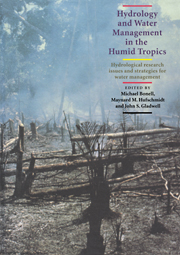 Hydrology and Water Management in the Humid Tropics
Hydrology and Water Management in the Humid Tropics Book contents
- Frontmatter
- Contents
- List of Authors
- Foreword by Federico Mayor, Director-General, UNESCO
- Preface
- Cartographic Credit
- Acknowledgements
- SECTION I INTRODUCTION
- SECTION II HUMID TROPICS SETTING
- SECTION III REGIONAL HYDROLOGY
- SECTION IV PHYSICAL PROCESSES
- SECTION V PHYSICAL PROCESSES – HUMAN USES: THE INTERFACE
- SECTION VI MANAGEMENT ISSUES
- 22 Water Resource Management
- 23 Water Management Issues: Population, Agriculture and Forests – A Focus on Watershed Management
- 24 Urban Water Resources in the Humid Tropics: An Overview of the ASEAN Region
- 25 Urban Water Problems in the Humid Tropics
- 26 Rethinking Urban Water Supply and Sanitation Strategy in Developing Countries in the Humid Tropics: Lessons from the International Water Decade
- 27 Water Resource Management Issues in the Humid Tropics
- SECTION VII APPENDICES
- Place index
27 - Water Resource Management Issues in the Humid Tropics
Published online by Cambridge University Press: 23 December 2009
- Frontmatter
- Contents
- List of Authors
- Foreword by Federico Mayor, Director-General, UNESCO
- Preface
- Cartographic Credit
- Acknowledgements
- SECTION I INTRODUCTION
- SECTION II HUMID TROPICS SETTING
- SECTION III REGIONAL HYDROLOGY
- SECTION IV PHYSICAL PROCESSES
- SECTION V PHYSICAL PROCESSES – HUMAN USES: THE INTERFACE
- SECTION VI MANAGEMENT ISSUES
- 22 Water Resource Management
- 23 Water Management Issues: Population, Agriculture and Forests – A Focus on Watershed Management
- 24 Urban Water Resources in the Humid Tropics: An Overview of the ASEAN Region
- 25 Urban Water Problems in the Humid Tropics
- 26 Rethinking Urban Water Supply and Sanitation Strategy in Developing Countries in the Humid Tropics: Lessons from the International Water Decade
- 27 Water Resource Management Issues in the Humid Tropics
- SECTION VII APPENDICES
- Place index
Summary
ABSTRACT
The particular water management issues in the humid tropics arise from the hydrological features of this region (excess water, floods, greater variation of flows than in temperate zones), from the unique potential for hydro-power generation and from the traditional emphasis on growing irrigated rice. The central cause of water management problems is the rapid population growth with its increasing demand for water, food and energy, resulting in increasing pollution, and environmental and social problems. The capacity to deal with these problems is constrained by the limited availability of human and financial resources. Organizations at various levels, national and international, have been created to deal with the numerous issues, but the situation is far from satisfactory. Policy-makers and managers in the water sector should give special attention to the issues of institutional and water-sharing arrangements and make determined efforts to adopt modern tools and procedures to improve water development planning and implementation.
INTRODUCTION
Water utilization is on the increase as a result of rapid population growth. As rivers and lakes become more and more polluted, clean water becomes scarce; as public awareness of clean water dependency intensifies, so does the demand for efforts to protect this resource. But there is a disparity between official policies and plans for water resource utilization, and the actual implementation efforts, as is the case for resources in general. In view of these broad issues, there is a need to determine realistic water development policies for efficient, integrated and environmentally sound water resource utilization.
- Type
- Chapter
- Information
- Hydrology and Water Management in the Humid TropicsHydrological Research Issues and Strategies for Water Management, pp. 556 - 568Publisher: Cambridge University PressPrint publication year: 1993
